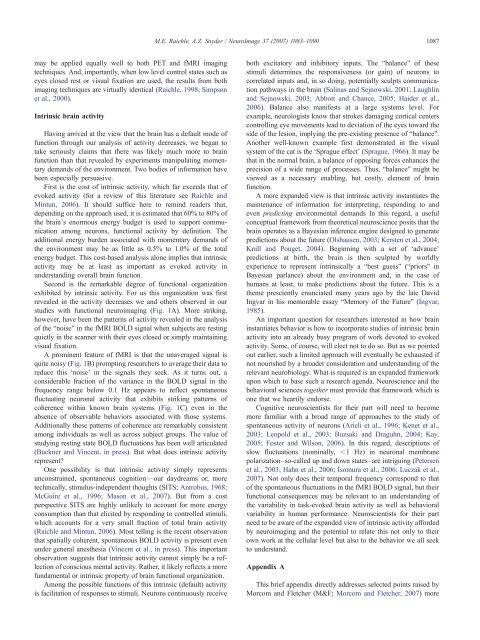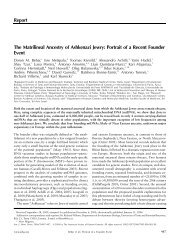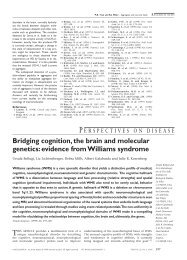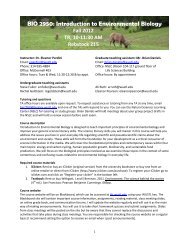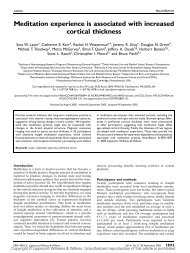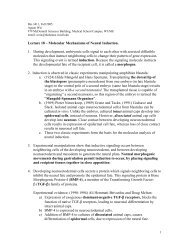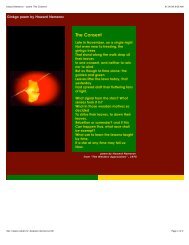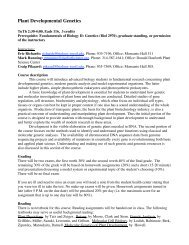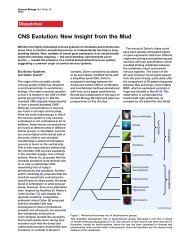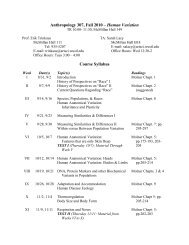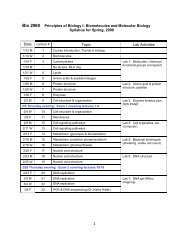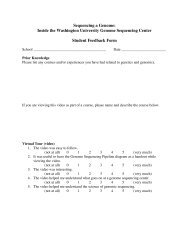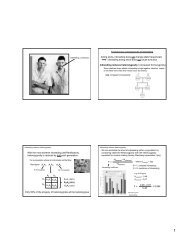1086 M.E. Raichle, A.Z. Snyder / NeuroImage 37 (2007) 1083–1090ch<strong>an</strong>ges <strong>of</strong> the type seen in Fig. 1A. 6 One <strong>of</strong> the referees wrote, “Thisis the most controversial aspect <strong>of</strong> this paper as it (1) c<strong>an</strong>not be ruledout that these signal ch<strong>an</strong>ges are actual activations in the so-calledresting state <strong>an</strong>d (2) the physiological mech<strong>an</strong>isms underpinning agenuine BOLD signal decrease remain a matter <strong>of</strong> speculation”. 7It was clear that we needed a way to determine whether or nottask-induced activity decreases were simply ‘activations’ present inthe absence <strong>of</strong> <strong>an</strong> externally-directed task <strong>an</strong>d <strong>an</strong> expl<strong>an</strong>ationregarding why they should appear in both PET <strong>an</strong>d fMRI<strong>function</strong>al neuroimaging studies. In wrestling with these difficultissues two things came to mind that, together, we felt <strong>of</strong>fered us <strong>an</strong>opportunity to move forward. 8First, the m<strong>an</strong>ner in which <strong>function</strong>al neuroimaging wasconducted with fMRI carried with it a physiological definition <strong>of</strong>activation that could be measured with PET. This definition arosefrom qu<strong>an</strong>titative circulatory <strong>an</strong>d metabolic PET studies demonstratingthat when <strong>brain</strong> activity increases tr<strong>an</strong>siently above aresting state, blood flow increases more th<strong>an</strong> oxygen consumption(Fox <strong>an</strong>d Raichle, 1986; Fox et al., 1988). As a result, the amount<strong>of</strong> oxygen in blood increases locally as the ratio <strong>of</strong> oxygenconsumed to oxygen delivered falls. This ratio is known as theoxygen extraction fraction or the OEF. Activation c<strong>an</strong> then bedefined physiologically as a tr<strong>an</strong>sient local decrease in the oxygenextraction or, if you like, a tr<strong>an</strong>sient increase in oxygen availability.The practical consequence <strong>of</strong> this observation was to lay thephysiological groundwork for <strong>function</strong>al MRI using blood oxygenlevel dependent or BOLD contrast, (Thus, MRI is sensitive to thelevel <strong>of</strong> blood oxygenation; Thulborn et al., 1982; Ogawa et al.,1990, 1992; Kwong et al., 1992). Using this qu<strong>an</strong>titative definition<strong>of</strong> activation we asked whether ‘activations’ were present in apassive state such as visual fixation or eyes closed rest. Butactivation must be defined relative to something. How was that tobe accomplished if there was no ‘control’ state for eyes closed restor visual fixation?The definition <strong>of</strong> a control state for eyes closed rest or visualfixation arose from a second critical piece <strong>of</strong> physiologicalinformation. Researchers using PET for the qu<strong>an</strong>titative measurement<strong>of</strong> <strong>brain</strong> oxygen consumption <strong>an</strong>d blood flow had longappreciated the fact that, across the entire <strong>brain</strong>, blood flow <strong>an</strong>doxygen consumption are closely matched when one lies in a PETsc<strong>an</strong>ner with eyes closed resting or during visual fixation (seeLebrun-Gr<strong>an</strong>die et al., 1983 for one <strong>of</strong> the earliest references; alsoRaichle et al., 2001). This is observed despite a nearly 4-folddifference in oxygen consumption <strong>an</strong>d blood flow between gray <strong>an</strong>dwhite matter <strong>an</strong>d variations in both measurements <strong>of</strong> greater th<strong>an</strong>30% within gray matter itself. As a result <strong>of</strong> this close matching <strong>of</strong>blood flow <strong>an</strong>d oxygen consumption at rest, the OEF is strikinglyuniform throughout the <strong>brain</strong>. This well-established observation ledus to the hypothesis that if this observation (a uniform OEF at rest)was correct then activations, as defined above, were likely absent inthe resting state (Raichle et al., 2001). We decided to test thishypothesis.Using PET to qu<strong>an</strong>titatively assess regional OEF, we examinedtwo groups <strong>of</strong> normal subjects in the resting state <strong>an</strong>d initially6 The study, never published, was a comparison <strong>of</strong> PET <strong>an</strong>d fMRI.7 Such a response was not surprising given the work with reversesubtractions in dealing with the assumption <strong>of</strong> pure insertion.8 What follows is a <strong>brief</strong> synopsis <strong>of</strong> complex physiological observations.For readers interested in more details we recommend our recent reviewdealing in depth with this subject (Raichle <strong>an</strong>d Mintun, 2006).confined our <strong>an</strong>alysis to those areas <strong>of</strong> the <strong>brain</strong> frequentlyexhibiting the aforementioned imaging signal decreases (Fig. 1A).In this <strong>an</strong>alysis we found no evidence that these areas wereactivated in the resting state; that is, the average OEF in theseareas did not differ signific<strong>an</strong>tly from other areas <strong>of</strong> the <strong>brain</strong>. Weconcluded that the regional decreases, observed commonly duringtask perform<strong>an</strong>ce, represented the presence <strong>of</strong> <strong>function</strong>ality thatwas ongoing (i.e., sustained as contrasted to tr<strong>an</strong>siently activated 9 )in the resting state <strong>an</strong>d attenuated only when resources weretemporarily reallocated during goal-directed behaviors; hence ouroriginal designation <strong>of</strong> them as <strong>default</strong> <strong>function</strong>s (Raichle et al.,2001). Thus, from a metabolic/physiologic perspective, these areas(Fig. 1A) could not be distinguished from other areas <strong>of</strong> the <strong>brain</strong>in the resting state.After performing the above <strong>an</strong>alysis (Raichle et al., 2001) onthe aforementioned areas (Fig. 1A), we searched our data for <strong>an</strong>yother areas that might exhibit evidence <strong>of</strong> activation in the restingstate <strong>an</strong>d found none (Raichle et al., 2001). 10 This observation isimport<strong>an</strong>t in suggesting that aspects <strong>of</strong> the <strong>brain</strong>'s intrinsic<strong>function</strong>ality are not confined to those areas that we designatedas a <strong>default</strong> network (Fig. 1A) <strong>an</strong>d is consistent with theobservation that activity decreases do occur in other areas <strong>of</strong> the<strong>brain</strong> in a more task specific m<strong>an</strong>ner (Drevets et al., 1995;Kawashima et al., 1995; Ghat<strong>an</strong> et al., 1998; Somers et al., 1999;Smith et al., 2000; Amedi et al., 2005; Shmuel et al., 2006). 11The import<strong>an</strong>ce <strong>of</strong> using PET rather th<strong>an</strong> fMRI to define aphysiologic baseline state <strong>of</strong> the <strong>brain</strong> needs to be emphasized. Ourwork was critically dependent on the ability <strong>of</strong> PET to prov<strong>idea</strong>bsolute, qu<strong>an</strong>titative <strong>an</strong>d reproducible measurements <strong>of</strong> regionalblood flow <strong>an</strong>d oxygen consumption in the hum<strong>an</strong> <strong>brain</strong>. PET isuniquely suited to do so, operating as it does with tracer techniquesthat have been validated against objective st<strong>an</strong>dards (Raichle et al.,1983; Mintun et al., 1984; Martin et al., 1987). fMRI as it isconventionally practiced using BOLD imaging does not <strong>of</strong>fer asimilar absolute reference (Aguirre et al., 2002; Detre <strong>an</strong>d W<strong>an</strong>g,2002) <strong>an</strong>d, hence, estimated ch<strong>an</strong>ges in parameters such as oxygenconsumption must be viewed with caution until further work isdone to determine their validity (e.g., see Kim et al., 1999).Furthermore, when fMRI is employed comparisons are alwaysmade between two states closely spaced in time because baselineBOLD signal, for reasons currently not understood, does notremain const<strong>an</strong>t. Some have concluded, therefore, that a <strong>function</strong>alimaging baseline c<strong>an</strong>not be defined. We appreciate the potential forconfusion particularly when terms like control state, controlcondition <strong>an</strong>d baseline are used interch<strong>an</strong>geably, which occursfrequently in the imaging literature. While the term physiologicbaseline, as we have defined it (Gusnard <strong>an</strong>d Raichle, 2001;Raichle et al., 2001), is not appropriately applied to fMRI datadirectly, it is clear that the terms control state <strong>an</strong>d control condition9 It should be noted that with sustained increases in activity (i.e.,activations) the OEF gradually returns towards its pre-activation levelsMintun et al. (2002).10 Readers <strong>of</strong> our paper (Raichle et al., 2001) will note that we observedincreases in the OEF (so-called “deactivations”) in areas <strong>of</strong> extrastriatevisual cortex. This finding had been noticed m<strong>an</strong>y years before in theearliest investigations <strong>of</strong> the OEF in hum<strong>an</strong>s (Lebrun-Gr<strong>an</strong>die et al., 1983).Interested readers may wish to consult our paper for a more completediscussion <strong>of</strong> this finding.11 It should also be noted that the work <strong>of</strong> Shmuel <strong>an</strong>d colleagues (Shmuelet al., 2006) provided us with the first direct evidence that activity decreasesseen with fMRI represented actual reductions in neuronal activity.
M.E. Raichle, A.Z. Snyder / NeuroImage 37 (2007) 1083–10901087may be applied equally well to both PET <strong>an</strong>d fMRI imagingtechniques. And, import<strong>an</strong>tly, when low level control states such aseyes closed rest or visual fixation are used, the results from bothimaging techniques are virtually identical (Raichle, 1998; Simpsonet al., 2000).Intrinsic <strong>brain</strong> activityHaving arrived at the view that the <strong>brain</strong> has a <strong>default</strong> <strong>mode</strong> <strong>of</strong><strong>function</strong> through our <strong>an</strong>alysis <strong>of</strong> activity decreases, we beg<strong>an</strong> totake seriously claims that there was likely much more to <strong>brain</strong><strong>function</strong> th<strong>an</strong> that revealed by experiments m<strong>an</strong>ipulating momentarydem<strong>an</strong>ds <strong>of</strong> the environment. Two bodies <strong>of</strong> information havebeen especially persuasive.First is the cost <strong>of</strong> intrinsic activity, which far exceeds that <strong>of</strong>evoked activity (for a review <strong>of</strong> this literature see Raichle <strong>an</strong>dMintun, 2006). It should suffice here to remind readers that,depending on the approach used, it is estimated that 60% to 80% <strong>of</strong>the <strong>brain</strong>'s enormous energy budget is used to support communicationamong neurons, <strong>function</strong>al activity by definition. Theadditional energy burden associated with momentary dem<strong>an</strong>ds <strong>of</strong>the environment may be as little as 0.5% to 1.0% <strong>of</strong> the totalenergy budget. This cost-based <strong>an</strong>alysis alone implies that intrinsicactivity may be at least as import<strong>an</strong>t as evoked activity inunderst<strong>an</strong>ding overall <strong>brain</strong> <strong>function</strong>.Second is the remarkable degree <strong>of</strong> <strong>function</strong>al org<strong>an</strong>izationexhibited by intrinsic activity. For us this org<strong>an</strong>ization was firstrevealed in the activity decreases we <strong>an</strong>d others observed in ourstudies with <strong>function</strong>al neuroimaging (Fig. 1A). More striking,however, have been the patterns <strong>of</strong> activity revealed in the <strong>an</strong>alysis<strong>of</strong> the “noise” in the fMRI BOLD signal when subjects are restingquietly in the sc<strong>an</strong>ner with their eyes closed or simply maintainingvisual fixation.A prominent feature <strong>of</strong> fMRI is that the unaveraged signal isquite noisy (Fig. 1B) prompting researchers to average their data toreduce this ‘noise’ in the signals they seek. As it turns out, aconsiderable fraction <strong>of</strong> the vari<strong>an</strong>ce in the BOLD signal in thefrequency r<strong>an</strong>ge below 0.1 Hz appears to reflect spont<strong>an</strong>eousfluctuating neuronal activity that exhibits striking patterns <strong>of</strong>coherence within known <strong>brain</strong> systems (Fig. 1C) even in theabsence <strong>of</strong> observable behaviors associated with those systems.Additionally these patterns <strong>of</strong> coherence are remarkably consistentamong individuals as well as across subject groups. The value <strong>of</strong>studying resting state BOLD fluctuations has been well articulated(Buckner <strong>an</strong>d Vincent, in press). But what does intrinsic activityrepresent?One possibility is that intrinsic activity simply representsunconstrained, spont<strong>an</strong>eous cognition—our daydreams or, moretechnically, stimulus-independent thoughts (SITS; Antrobus, 1968;McGuire et al., 1996; Mason et al., 2007). But from a costperspective SITS are highly unlikely to account for more energyconsumption th<strong>an</strong> that elicited by responding to controlled stimuli,which accounts for a very small fraction <strong>of</strong> total <strong>brain</strong> activity(Raichle <strong>an</strong>d Mintun, 2006). Most telling is the recent observationthat spatially coherent, spont<strong>an</strong>eous BOLD activity is present evenunder general <strong>an</strong>esthesia (Vincent et al., in press). This import<strong>an</strong>tobservation suggests that intrinsic activity c<strong>an</strong>not simply be a reflection<strong>of</strong> conscious mental activity. Rather, it likely reflects a morefundamental or intrinsic property <strong>of</strong> <strong>brain</strong> <strong>function</strong>al org<strong>an</strong>ization.Among the possible <strong>function</strong>s <strong>of</strong> this intrinsic (<strong>default</strong>) activityis facilitation <strong>of</strong> responses to stimuli. Neurons continuously receiveboth excitatory <strong>an</strong>d inhibitory inputs. The “bal<strong>an</strong>ce” <strong>of</strong> thesestimuli determines the responsiveness (or gain) <strong>of</strong> neurons tocorrelated inputs <strong>an</strong>d, in so doing, potentially sculpts communicationpathways in the <strong>brain</strong> (Salinas <strong>an</strong>d Sejnowski, 2001; Laughlin<strong>an</strong>d Sejnowski, 2003; Abbott <strong>an</strong>d Ch<strong>an</strong>ce, 2005; Haider et al.,2006). Bal<strong>an</strong>ce also m<strong>an</strong>ifests at a large systems level. Forexample, neurologists know that strokes damaging cortical centerscontrolling eye movements lead to deviation <strong>of</strong> the eyes toward theside <strong>of</strong> the lesion, implying the pre-existing presence <strong>of</strong> “bal<strong>an</strong>ce”.Another well-known example first demonstrated in the visualsystem <strong>of</strong> the cat is the ‘Sprague effect’ (Sprague, 1966). It may bethat in the normal <strong>brain</strong>, a bal<strong>an</strong>ce <strong>of</strong> opposing forces enh<strong>an</strong>ces theprecision <strong>of</strong> a wide r<strong>an</strong>ge <strong>of</strong> processes. Thus, “bal<strong>an</strong>ce” might beviewed as a necessary enabling, but costly, element <strong>of</strong> <strong>brain</strong><strong>function</strong>.A more exp<strong>an</strong>ded view is that intrinsic activity inst<strong>an</strong>tiates themainten<strong>an</strong>ce <strong>of</strong> information for interpreting, responding to <strong>an</strong>deven predicting environmental dem<strong>an</strong>ds In this regard, a usefulconceptual framework from theoretical neuroscience posits that the<strong>brain</strong> operates as a Bayesi<strong>an</strong> inference engine designed to generatepredictions about the future (Olshausen, 2003; Kersten et al., 2004;Knill <strong>an</strong>d Pouget, 2004). Beginning with a set <strong>of</strong> ‘adv<strong>an</strong>ce’predictions at birth, the <strong>brain</strong> is then sculpted by worldlyexperience to represent intrinsically a “best guess” (“priors” inBayesi<strong>an</strong> parl<strong>an</strong>ce) about the environment <strong>an</strong>d, in the case <strong>of</strong>hum<strong>an</strong>s at least, to make predictions about the future. This is atheme presciently enunciated m<strong>an</strong>y years ago by the late DavidIngvar in his memorable essay “Memory <strong>of</strong> the Future” (Ingvar,1985).An import<strong>an</strong>t question for researchers interested in how <strong>brain</strong>inst<strong>an</strong>tiates behavior is how to incorporate studies <strong>of</strong> intrinsic <strong>brain</strong>activity into <strong>an</strong> already busy program <strong>of</strong> work devoted to evokedactivity. Some, <strong>of</strong> course, will elect not to do so. But as we pointedout earlier, such a limited approach will eventually be exhausted ifnot nourished by a broader consideration <strong>an</strong>d underst<strong>an</strong>ding <strong>of</strong> therelev<strong>an</strong>t neurobiology. What is required is <strong>an</strong> exp<strong>an</strong>ded frameworkupon which to base such a research agenda. Neuroscience <strong>an</strong>d thebehavioral sciences together must provide that framework which isone that we heartily endorse.Cognitive neuroscientists for their part will need to becomemore familiar with a broad r<strong>an</strong>ge <strong>of</strong> approaches to the study <strong>of</strong>spont<strong>an</strong>eous activity <strong>of</strong> neurons (Arieli et al., 1996; Kenet et al.,2003; Leopold et al., 2003; Buzsaki <strong>an</strong>d Draguhn, 2004; Kay,2005; Foster <strong>an</strong>d Wilson, 2006). In this regard, descriptions <strong>of</strong>slow fluctuations (nominally,


